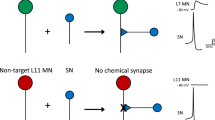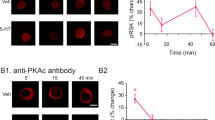Abstract
Sensitization of the gill- and siphon-withdrawal reflex in Aplysia is thought to result from a set of molecular processes with different time courses1: short-term sensitization is explained by cyclic AMP-dependent modulation of ion-channel function in sensory neurons lasting minutes2; memory that endures for hours or longer, by the expression and distribution within the neurons of new gene products3. Because gene induction and axonal transport are relatively slow, there may also be a need for a distinct form of intermediate memory to bridge the short- and long-term processes4. We now report that a protocol producing long-term sensitization results in a decrease in the amount of regulatory subunits of the cAMP-dependent protein kinase in animals 24 h after training, with no effect on the catalytic subunit. The loss appears to be post-translational. Because a decrease in the ratio of regulatory to catalytic subunits would result in elevated kinase activity after cAMP has returned to its unstimulated concentration in sensory cells, it could be the molecular mechanism of intermediate memory.
This is a preview of subscription content, access via your institution
Access options
Subscribe to this journal
Receive 51 print issues and online access
$199.00 per year
only $3.90 per issue
Buy this article
- Purchase on Springer Link
- Instant access to full article PDF
Prices may be subject to local taxes which are calculated during checkout
Similar content being viewed by others
References
Goelet, P., Castellucci, V. F., Schacher, S. & Kandel, E. R. Nature 322, 419–422 (1986).
Kandel, E. R. & Schwartz, J. H. Science 218, 433–443 (1982).
Montarolo, P. G. et al. Science 234, 1249–1254 (1986).
Schwar tz, J. H. & Greenberg, S. M. A. Rev. Neurosci. 10, 459–476 (1987).
Bernier, L., Castellucci, V. F., Kandel, E. R. & Schwartz, J. H. J. Neurosci. 2, 1682–1691 (1982).
Frost, W. N., Castellucci, V. F., Hawkins, R. D. & Kandel, E. R. Proc. natn. Acad. Sci. U.S.A. 82, 8266–8269 (1985).
Eppler, C. M., Palazzolo, M. J. & Schwartz, J. H. J. Neurosci. 2, 1692–1704 (1982).
Eppler, C. M., Bayley, H., Greenberg, S. M. & Schwartz, J. H. J. Cell Biol. 102, 320–321 (1986).
Walters, E. T., Byrne, J. H., Carew, T. J. & Kandel, E. R. J. Neurophysiol. 50, 1543–1559 (1983).
Greenberg, S. M., Bernier, L. & Schwartz, J. H. J. Neurosci. 7, 291–301 (1987).
Castellucci, V. F. et al. Proc. natn. Acad. Sci. U.S.A. 77, 7492–7496 (1980).
Castellucci, V. F., Nairn, A., Greengard, P., Schwartz, J. H. & Kandel, E. R. J. Neurosci. 2, 1673–1681 (1982).
Scholz, K. P. & Byrne, J. H. Science 235, 685–687 (1987).
Weiss, K. R., Mandelbaum, D. E., Schonberg, M. & Kupfermann, I. J. Neurophysiol. 42, 791–803 (1979).
Potter, R. L. & Taylor, S. S. J. biol. Chem. 255, 9706–9712 (1980).
Steinberg, R. A. & Agard, D. A. J. biol. Chem. 256, 10731–10734 (1981).
Beer, D. G., Butley, M. S. & Malkinson, A. M. Arch. Biochem. Biophys. 228, 207–219 (1984).
DeLotto, R. & Spierer, P. Nature 323, 688–692 (1986).
Rogers, S., Wills, R. & Rechsteiner, M. Science 234, 364–368 (1986).
Corbin, J. D., Sugden, P. H., West, L., Flockhart, D. A., Lincoln, T. M. & McCarthy, D. J. biol. Chem. 253, 3997–4003 (1978).
Rangel-Aldao, R., Kupiec, J. W. & Rosen, O. M. J. biol. Chem. 254, 2499–2508 (1979).
Kerlavage, A. R. & Taylor, S. S. J. biol. Chem. 257, 1749–1754 (1982).
Walter, U., Costa, M. R. C., Breakefield, X. O. & Greengard, P. Proc. natn. Acad. Sci. U.S.A. 76, 3251–3255 (1979).
Bubis, J. & Taylor, S. S. Biochemistry 24, 2163–2170 (1985).
Schaffner, W. & Weissman, C. Analyt. Biochem. 56, 502–514 (1973).
Schwechheimer, K. & Hofmann, F. J. biol. Chem. 252, 7690–7696 (1977).
Rannels, S. R., Beasley, A. & Corbin, J. D. Meth. Enzym. 99, 55–62 (1983).
Builder, S. E., Beavo, J. A. & Krebs, E. G. J. Biochem. 255, 3514–3519 (1980).
Author information
Authors and Affiliations
Rights and permissions
About this article
Cite this article
Greenberg, S., Castellucci, V., Bayley, H. et al. A molecular mechanism for long-term sensitization in Aplysia. Nature 329, 62–65 (1987). https://doi.org/10.1038/329062a0
Received:
Accepted:
Issue Date:
DOI: https://doi.org/10.1038/329062a0
This article is cited by
-
A first partial Aplysia californica proteome
Amino Acids (2011)
-
Dynamic Properties of Regulatory Motifs Associated with Induction of Three Temporal Domains of Memory in Aplysia
Journal of Computational Neuroscience (2005)
-
Possible molecular-cellular mechanisms of the regulation of gene expression during learning
Neuroscience and Behavioral Physiology (2000)
-
Ubiquitin-mediated proteolysis in learning and memory
Molecular Neurobiology (1999)
-
Role of G-proteins and second messenger systems in the plasticity of a defensive reflex in the common snail
Neuroscience and Behavioral Physiology (1998)
Comments
By submitting a comment you agree to abide by our Terms and Community Guidelines. If you find something abusive or that does not comply with our terms or guidelines please flag it as inappropriate.



